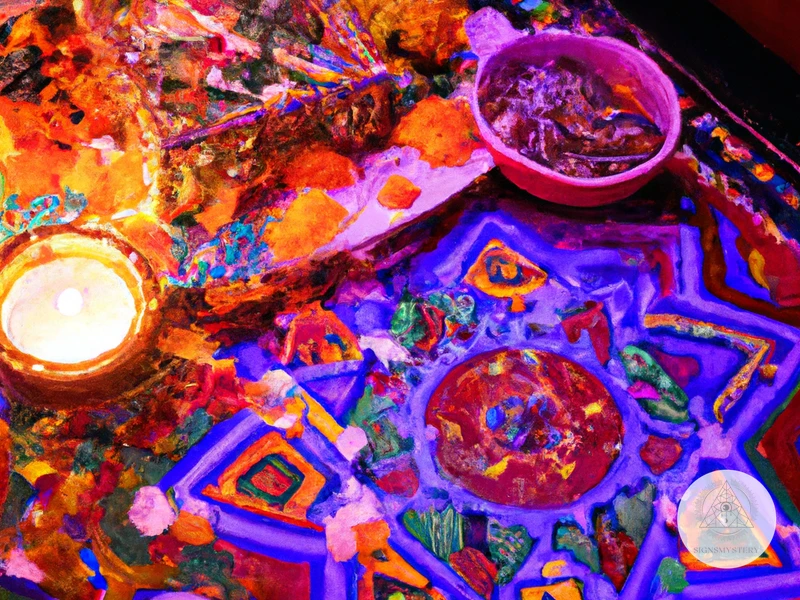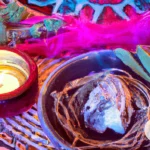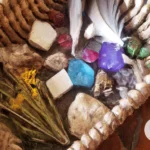Shamanic healing is an ancient practice that has been used by cultures all around the world for centuries. Shamanic healers use various tools to connect with the spiritual realm and provide healing for their patients. Two of the most common tools used in shamanic healing are mandalas and altars. These objects serve as powerful symbols and aid in creating a sacred space for healing rituals. In this article, we will explore the roles of mandalas and altars in shamanic healing rituals, how to create and use them, and provide examples of how they can be used in practice. So, let’s dive into the mystical world of shamanic healing!
What is a mandala?

A mandala is a complex design that often appears in religious and spiritual practices, such as Buddhism and Hinduism. In shamanic healing, mandalas play a significant role in helping the shaman connect with the spiritual realm and access deeper states of consciousness. These circular designs often include symmetry and repeating patterns that help to focus the mind and promote balance. Mandalas can be made from a variety of materials, such as sand, stones, or paint, and can be used in combination with other tools like chanting or meditation to aid in healing and self-discovery. To learn more about the importance of mandalas in shamanic healing, check out this article.
The role of mandalas in shamanic healing
The Role of Mandalas in Shamanic Healing
Mandalas are spiritual and ritual symbols that have been used for centuries in various cultures around the world. In shamanic healing practices, mandalas are utilized to represent the universe and to aid in spiritual and physical healing.
The following are the roles of mandalas in shamanic healing:
| Role of Mandalas in Shamanic Healing |
|---|
| Guiding Meditation |
| Mandalas can be used to focus the mind during meditation, leading to a deeper understanding of oneself and the universe. In shamanism, mandalas are used as a tool to journey to the spiritual realm and connect with spirit guides. |
| Grounding Energy |
| Mandalas are also used to ground and center energy. When creating a mandala, one may focus on an intention or specific energy, infusing it into the symbol. Meditating on the mandala helps to anchor that energy in one’s being. |
| Healing Properties |
| Used as an aid in healing rituals, mandalas are believed to have therapeutic properties. The intricate patterns work to calm the mind and promote relaxation, easing both physical and emotional pain. |
| Symbolic Meanings |
| Each component of the mandala holds symbolic meaning, representing different aspects of the individual, the universe, and the divine. By studying and meditating on the mandala’s symbolism, one can gain a deeper understanding of their spiritual path and their place in the universe. |
| Integration and Balance |
| The intricate patterns of the mandala work to integrate different parts of the self and bring balance. By working with the mandala, one can achieve a more holistic view of their being and learn to balance and harmonize different aspects of their life and inner self. |
Using mandalas in shamanic healing can be a powerful tool for emotional, physical, and spiritual growth. By meditating on the symbols and working with the energy they bring, one can gain deeper insight and understanding into their innermost self and the universe.
What is an altar?
An altar is a sacred space that is set up to facilitate spiritual practice and connection with the divine. This space can be created in a variety of forms depending on the individual’s spiritual path, but it typically includes items such as candles, stones, crystals, and other objects of spiritual significance. The role of the altar in shamanic healing is to create a safe and sacred space for the shamanic practitioner to connect with the spirit world and access guidance and healing energies. An altar can also be used to anchor intentions and energy, making it a powerful tool for manifestation and transformation. To learn more about the symbolism and creation of a shamanic altar, check out this helpful guide on creating your own shamanic altar.
The role of altars in shamanic healing
Altars are a physical space where shamanic practitioners can perform sacred rituals. An altar can be seen as a physical representation of the shamanic realm and is used to connect with the spirits and energies of the universe. Altars can be as simple or elaborate as the practitioner desires and often include items like crystals, feathers, and other sacred objects.
In shamanic healing, altars are used to create a space that feels safe and sacred for the shamanic journey. Altars can also be used to represent the elements or directions, depending on the practitioner’s tradition. The use of an altar can also help to ground and center the practitioner during the journey.
Some common items found on a shamanic altar include:
| Candles | Candles are often used to represent the element of fire and are used to provide light during the journey. |
| Crystals | Crystals are believed to have healing properties and can be used to amplify energy during the journey. |
| Feathers | Feathers are often used to represent the element of air and can be used to aid in communication with the spirit world. |
| Drums or rattles | Drums or rattles are used to create a steady rhythm during the journey and can help to shift the practitioner into a trance state. |
| Offerings | Offerings such as tobacco and sage can be used to show respect to the spirits and create a welcoming atmosphere for the journey. |
The symbolism of the items on the altar will differ depending on the tradition. For example, a feather may represent the element of air in one tradition, but it may represent the spirit of an animal guide in another tradition.
In addition to using an altar during the journey, shamanic practitioners may also use an altar to honor the spirits and ancestors in their everyday life. The altar can be seen as a physical representation of gratitude and reverence for the spiritual world.
The use of an altar can enhance shamanic healing by creating a sacred and safe space for the journey. Whether simple or elaborate, an altar can help to ground the practitioner and connect them with the energies of the universe.
Mandala and altar creation

Creating a mandala or an altar for shamanic practice is a deeply personal and spiritual process. The mandala is a representation of the cosmos and an expression of the creator’s inner world. To make a mandala for shamanic practice, one should choose colors and symbols that correspond to the intention of the ritual and their spiritual beliefs. Similarly, setting up an altar involves selecting objects that hold symbolic significance and arranging them in a way that promotes focus and meditation. Some common items that can be found on an altar include candles, crystals, herbs, and feathers. The process of creating a mandala or altar can be just as therapeutic and transformative as the shamanic healing ritual itself. For more information on the meanings of mandalas in shamanism, check out this article. If you’re interested in using mandalas and altars in shamanic journeying, read this guide.
How to design and make a mandala for shamanic practice
Creating a mandala for shamanic practice is a deeply personal and spiritual process. It’s a way of connecting with your inner self and the universe around you. Here is a step-by-step guide on how to design and make your own mandala for shamanic practice.
Step 1: Choose the Purpose of Your Mandala
The first step is to determine the purpose of your mandala. It could be for healing, meditation, manifestation, or simply to enhance your spiritual practice. The intention behind the mandala will guide your design and help you choose the right colors and symbols.
Step 2: Choose Your Symbols and Colors
Next, choose the symbols and colors that represent your intention. You can use ancient shamanic symbols, elements from nature, animals, or anything that speaks to your soul. You can choose as many or as few as you like. Remember that each color carries energy and symbolism, so choose colors that resonate with your intention.
Step 3: Choose Your Materials
You can create your mandala using various materials such as paint, colored pencils, markers, or even natural elements like stones, leaves, and flowers. Choose materials that you feel drawn to and that will allow you to create your vision.
Step 4: Design Your Mandala
Now it’s time to start designing. Begin by drawing a circle in the center of your paper or canvas. This circle represents the sacred space where your intention will be manifested. Then, start adding the symbols and colors you have chosen in a symmetrical pattern around the central circle. You can start from the center and work your way out or work in a clockwise direction.
Step 5: Meditate and Focus Your Energy
As you create your mandala, take breaks to meditate and focus your energy on your intention. You can also use crystals, essential oils, or other tools to enhance your focus and intention. Remember that your mandala is a reflection of your inner self, and each stroke of the brush or pencil is an opportunity to connect with your spirit.
Step 6: Complete Your Mandala
Once you have finished designing your mandala, take a step back and appreciate the beauty of your creation. You can now use it in your shamanic practice, either by meditating on it or by incorporating it into your altar. Remember that your mandala is a representation of your intention and a source of spiritual energy.
Creating a mandala for shamanic practice is a meaningful and transformative experience. It can help you connect with your inner self, enhance your spiritual practice, and manifest your intentions. So, take your time, focus your energy, and let your creativity flow.
How to set up and maintain an altar for shamanic practice
Setting up and maintaining an altar for shamanic practice requires attention to detail and intention. Here are some steps to help you create your own shamanic altar:
1. Choose a location: Look for a location in your home that is private, quiet, and peaceful. Ideally, it should be a space where you can meditate and practice your shamanic rituals undisturbed.
2. Choose a surface: Your altar can be set up on any surface that is flat and stable. You can use a table, a shelf, or even a simple mat on the floor.
3. Select altar objects: Choose objects that have personal and spiritual significance to you. These can include crystals, feathers, statues, candles, and other items that hold special meaning. You could also include objects from nature, such as plants or stones.
4. Arrange altar objects: When arranging your altar objects, do so with intention. You may want to position them in a way that represents the four cardinal directions or in a way that feels energetically balanced to you.
5. Cleanse and bless your altar: Before using your altar, take some
Subscribe to Our Newsletter
Sign up to receive the latest news and updates.
6. Maintain your altar: Keep your altar clean and tidy, and regularly refresh any offerings you have placed on it. Try to connect with your altar daily, even if only for a few moments, to help maintain its energy.
Remember that your shamanic altar is a personal and sacred space, so feel free to be creative and adapt these steps to your own spiritual practice.
Using mandalas and altars in shamanic healing rituals
The use of mandalas and altars in shamanic healing rituals is an important aspect of the practice. Mandalas are geometric designs that symbolize the universe and serve as a visual aid in meditation and healing. Altars are spaces set aside for ritualistic offerings and spiritual devotion. During a shamanic healing session, the shaman may use a mandala to help focus their intent or guide the client through a meditation. The altar may hold items such as crystals, candles, or feathers that hold symbolic meaning and aid in the healing process. Using these tools can help individuals connect with their inner selves, higher powers, or spirits, aiding in the healing of both physical and emotional ailments. Each shamanic healing session is unique and can be tailored to the individual’s specific needs, but the use of mandalas and altars can be a powerful addition to the experience.
Examples of shamanic healing rituals using mandalas and altars
Examples of shamanic healing rituals using mandalas and altars:
1. Chakra Balancing: In this ritual, a mandala is created with different colors and symbols representing each chakra. The person receiving the healing will lie down on the mandala and the shaman will place corresponding crystals or other objects on the chakra points. An altar may be set up with items representing each chakra, such as candles or figurines.
2. Ancestral Healing: For this ritual, an altar is set up with pictures or objects representing the ancestors of the person receiving the healing. A mandala may also be created with symbols representing the ancestors. The shaman will then invite the ancestors to participate in the healing and offer blessings to the person.
3. Dream Work: In this ritual, a mandala is created with symbols representing different dream archetypes. The person receiving the healing will choose a symbol that resonates with them and the shaman will guide them through a journey to explore its meaning. An altar may be set up with items related to dreaming, such as dreamcatchers or herbs used for dream work.
4. Elemental Healing: This ritual involves creating a mandala with symbols representing the elements of air, water, fire, and earth. The person receiving the healing will lie down on the mandala and the shaman will use corresponding elements, such as feathers or stones, to balance the person’s energy. An altar may be set up with items representing each element, such as incense for air and a bowl of water for water.
5. New Beginnings: For this ritual, a mandala is created with symbols representing new beginnings, such as the sun rising or a seed sprouting. The person receiving the healing will visualize their intentions for a new beginning while sitting on the mandala. An altar may be set up with items such as flowers or candles symbolizing rebirth.
All of these rituals incorporate the use of mandalas and altars to enhance the shamanic healing experience and provide a sacred space for the individual receiving the healing. It is important to consult a trained shaman before attempting any of these rituals on your own.
Conclusion
Conclusion:
In conclusion, mandalas and altars play vital roles in shamanic healing rituals. Mandalas are powerful tools for centering and focusing the mind, while altars provide a physical anchor and gateway to meaningful spiritual experiences. By creating and working with mandalas and altars, shamans can tap into the healing power of the universe and connect with their higher selves.
Designing and making a mandala is a creative process that requires attention to detail and mindful intention. Similarly, setting up and maintaining an altar is a personal task that should reflect the individual needs and desires of the shaman. Both mandalas and altars can be used in shamanic healing rituals to create a sacred and protected space that facilitates deep healing and transformation.
Examples of shamanic healing rituals using mandalas and altars include using a mandala as a focal point for meditation and journeying, and using an altar as a physical representation of the elements and spirits being invoked in the healing ritual. These practices can be adapted and customized to suit the needs of individual shamans and their clients.
Overall, incorporating mandalas and altars into shamanic healing practices can enhance the healing potential of the ritual and deepen the shaman’s connection to the spiritual realm. With careful attention to detail and intention, mandalas and altars can become powerful tools for facilitating transformation and healing in both the shaman and those seeking healing.
| Key takeaways: |
| – Mandalas and altars are important tools in shamanic healing rituals |
| – Mandalas help to center and focus the mind, while altars provide a physical anchor to spiritual experiences |
| – Mandalas and altars can be customized to suit the needs of individual shamans and clients |
| – Using mandalas and altars in shamanic healing rituals can deepen the shaman’s connection to the spiritual realm |
| – Mindful attention to detail and intention is essential when creating and working with mandalas and altars |
Frequently Asked Questions
What types of mandalas are most commonly used in shamanic healing?
There is no specific type of mandala used in shamanic healing, as they can come in various forms, such as sand mandalas, crystal mandalas, and fabric mandalas.
What materials are typically used in creating a mandala?
The materials used can vary depending on the type of mandala being created. For example, a sand mandala may use colored sand, while a fabric mandala may use various types of fabric and adornments.
What is the purpose of creating an altar in shamanic healing?
Altars are used as a sacred space for offerings, prayers, and rituals. They serve as a physical representation of the spiritual realm and the connection between the shaman and the divine.
What types of items are typically found on a shamanic altar?
Items found on a shamanic altar can vary, but commonly include crystals, feathers, candles, herbs, flowers, and other spiritual or symbolic objects.
Can anyone create and use a mandala or altar for shamanic healing?
Yes, anyone can create and use a mandala or altar for shamanic healing. However, it is important to approach the practice with respect and intention.
What is the significance of the colors used in a mandala?
Each color in a mandala holds a different meaning and symbolism. For example, red may represent passion and energy, while blue may represent calmness and peace.
How does using a mandala aid in shamanic healing?
Using a mandala in shamanic healing can aid in creating a sacred and peaceful space for the shaman and the client. It can also serve as a tool for focus and intention during the healing process.
What is the role of intention in creating a shamanic altar?
Intention plays a crucial role in creating a shamanic altar. It is important for the shaman to set a clear intention for the altar and its purpose, as well as regularly infusing it with positive energy and intention.
What is the difference between a personal altar and a community altar?
A personal altar is a sacred space created for the individual shaman, while a community altar is created for the entire shamanic community to use and contribute to.
Are there any potential dangers or negative effects to using mandalas or altars in shamanic healing?
When used with respect and intention, there are typically no negative effects to using mandalas or altars in shamanic healing. However, it is important for the shaman to regularly cleanse and maintain the objects on the altar to ensure positive and safe energy.










